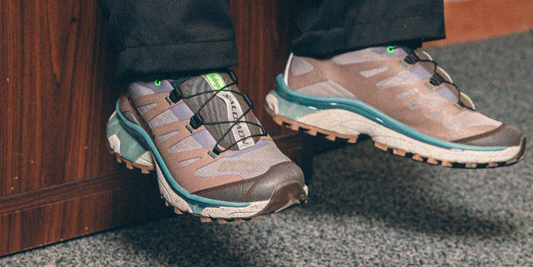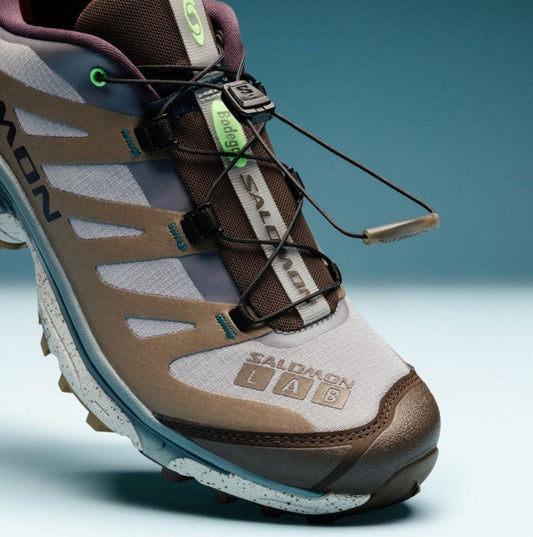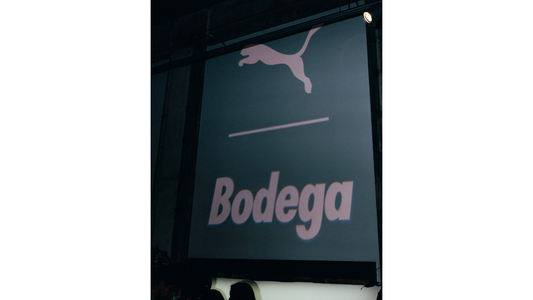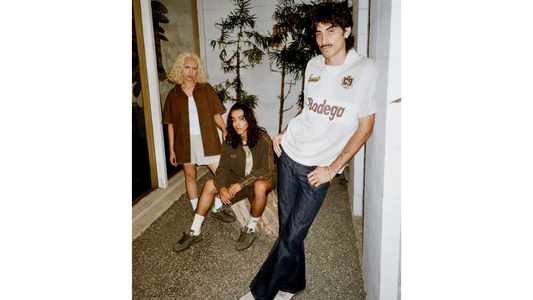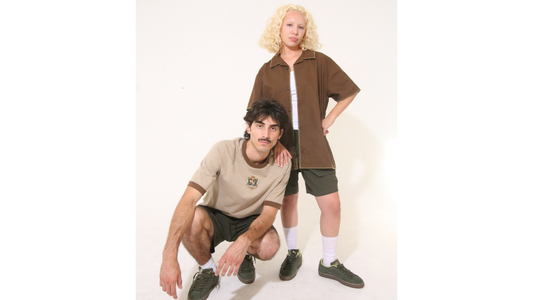In the early-1980s, a cultural phenomenon was beginning to take shape in the city of Boston. United through an inexplicable and exclusive allegiance to the adidas brand, much of the city’s youth would rally around a German sneaker manufacturer, and in doing so, form a new sense of local pride and loyalty where fidelity was shown through fashion.
To gain some insight into the city’s complex relationship with the adidas, Bodega called upon three veterans of the Boston hip-hop scene for first hand accounts from the formative years of the intriguing and enduring adidas/Boston relationship.
“I do have a strong connection with the brand, but when it comes down to what legitimized it for us and what made it become a Boston staple thing, I don’t really know,” said graffiti artist Rob Gibbs (aka Problak). “That connection was always pretty mysterious. I will say, RUN DMC’s ‘My Adidas’ was a huge part of it. It just put the crown on making sure that you had a pair. Now you had an anthem to get behind.”
Photos of Rob Gibbs aka Problak in front of his mural, "Breathe Life 3"
By the time RUN DMC released Raising Hell in 1986, adidas had already helped define how hip hop looked, but after the release of the single, “My Adidas,” the brand was catapulted from a mere fashion footnote to its newfound place as the foundation and official uniform of an entire movement.
Promotional Video starring RUN DMC and Patrick Ewing
“Adidas had already been part of the dance community since the early 1980s,” said breakdancer and Floorlords founder Lino Delgado. “We used to buy Shelltoes and the Campus. I remember the dancers back then always danced and dressed in Adidas sweatsuits. When RUN DMC came out we looked at them like they dressed like us. Before them, rappers dressed in leather pants, jackets, vest and boots—a little bit like Funkadelic. RUN DMC’s look was more like the Bboy/Bgirl style.”
Photos of Lino Delgado of the Floorlords, taken by Mason Rose
Despite the fact that RUN DMC hailed from Hollis, Queens, their look was something relatable and their “adi-anthem” would become a rallying cry that cemented the brand’s clout within Boston city limits. The fact that the NYC footwear scene was already decidedly dominated by Nike made Boston’s alliance with adidas all the more appealing. Plus, if anyone wanted to question the city’s decision to rally behind the rap trio, let’s not forget that the track that followed “My Adidas” on the Raising Hell just happened to be a rap redux of the rock n roll anthem “Walk This Way,” which famously paired the hip hop trio next to Boston rock legends, Aerosmith. So there was that.
“Sure, Boston was adidas town, but there was also a very big anti-Nike vibe too,” remembers graffiti artist Jason Talbot (aka SWAT). “I feel like it was akin to the Boston versus NYC vibe. There has always been a rivalry there as well. As much as Bostonians had a real animosity to New York, we also kind of wish we were New York, you know. It’s a David vs Goliath thing. We were always trying to prove ourselves and the adidas versus Nike thing became another part of that competitive nature.”
Archival Images of Jason Talbot (aka SWAT)
Archival Images provided by Sut
At its most optimistic, adidas became an expression of city pride. But at its extreme, that pride escalated and became a non-negotiable point of contention for area gangs. Walk down the wrong neighborhood street wearing anything but the Three Stripes, and you would most likely end up walking home barefoot ...at the very least.
“Gangs became a big thing after the movie Colors came out,” said Delgado. “We always had streets that stuck together, but after Colors we had neighborhoods wearing different sports teams and different styles of adidas to match and represent their street or gang.”
And then of course there were the Adidas trees. “The most famous one was in Adidas Park in Roxbury on Intervale Street,” remembers Delgado. “If you got caught wearing any other brands you was getting them taken off and tossed in the trash and probably beat up. There was a tree there that had tons of shoes in it. It looked like a Christmas tree with all the adidas in it. I never got caught up there, but heard many stories.”
“There were definitely certain streets you couldn’t go down if you didn’t have adidas on,” Gibbs continues. “The crazy thing is, depending on what block you were from, the adidas tree meant something different. Where I was from, we had two adidas trees. Back then we played ball super hard. If you balled out and you wore your sneakers out, you just threw them up in the tree. Other times you’d throw a pair of sneakers up there for someone who passed away.”
Like most things formed out of special semi-secret allegiance, the adidas/Boston connection also gave birth to a method of shared identification between like parties, in this case a unique and esoteric “gang” symbol and hand gesture that was known as “Throwing Threes.” Making a lowercase “b” with your index and thumb not only saluted Boston, but the middle, ring and pinky fingers repp’d the Three Stripes.
“When you put the three fingers out, it’s like the okay sign,” notes Gibbs. “And then you have the three for the stripes. It’s like earning your stripes. It’s a strong recognition of what adidas stood for.” The gesture, which has been immortalized in rap verses has been notably flashed by everyone from professional basketball players to Mayor Menino.
Though its gang affiliation may have provided a tasty scoop for reporters quick to link increased violence to pricey sneakers, Boston’s allegiance to adidas was, at its core, an extreme example of local pride. And it wasn’t long before the more positive traits associated with it like loyalty, community, identity and camaraderie, trickled down from the gangs to the impressionable kids from the communities they represented. While adidas appeal to the spirit of youth was inherent, that sense of rebellion would play out in many different ways.
“I feel like it started off gang-related,” recalls Talbot. “The gang thing made it something you wanted to be a part of. It gave it that mystique. I mean, I can’t say that I wanted to wear adidas because of gangs. It was more so my friends being like, ‘what’s up with you wearing Nikes?’ Graffiti and hip hop were my ways of staying out of gang affiliation. You know it’s the five elements of hip hop: deejaying, rapping, breakdancing, graffiti and beat boxing. I stuck with the graffiti side. I mean as far as hip hop goes it was always the most illegal part of the equation. Everything else was monetized. Rap music was on the radio, the breakdancers and Bboys were in the club, but we were still on the streets getting in trouble spray painting and tagging. For me graffiti was the biggest rush. You just felt like a secret agent out there, trying to get your name up. And once your name was up, it was just phenomenal. At first I was bombing streets heavy. My tag was SWAT. So when I would introduce myself as SWAT people would say “Oh that’s you?!” Once you were there, there was a captive audience. Everybody knew SWAT. There was a goal to be famous. You wanted to be known around the neighborhood and make a name for yourself. We wanted to be badasses. We didn’t want to conform, but we also didn’t want to hurt anybody. It was always like, ‘I’m a criminal, but I’m performing this victimless crime.’ We were good kids you know, but we weren’t chumps and nerds and geeks, you know. We were still going to be on the streets.”
From Shelltoes to Top Tens, Yum Yums to Forums, certain streets of Boston wore different colors and styles, but in the end it was the Three Stripes that mattered most. And while many of the silhouettes were conceived for sports, it was more often hip hop culture that dictated style trends. Sure Patrick Ewing was from Cambridge and wore adidas, but since most of his silhouettes came in New York Knicks colorways, it didn’t present a viable option for the average begrudged Bostonian to pay tribute. Instead of the traditional influence of athletes, all eyes were turning to the icons of urban music for inspiration.
“I was into collecting vinyl and I remember the first time I saw the “They Reminisce Over You,” single. CL Smooth had on those Silver and Black Forums. I knew I had to have them. You know what I mean, I needed those shits. It was the people in hip-hop, whatever you saw in the magazines and on album covers, that made it happen. When I saw CL Smooth rockin those silver and black Forums and I was like “this is it. This is what’s going to take it there.” I remember when Harry the Greeks brought out those Black and White Forums. I think it must have been an overstock or something. When that pair of black and white Forums was finally afloat, everybody and their mother had those Forums. Four of my other homies had them too. It looked like we were on a team or something.”
Back in the day style was informed by MTV, music magazines and word of mouth. When a new style hit the market, people headed en masse to Harry the Greeks in the South End or Alpha Omega in Roxbury. “Alpha Omega was a staple spot where you could get adidas from 4 or 5 years back because they kept an inventory that was sick,” Gibbs recalls. “But they were also known for their classic sweaters and sweatsuits. They had all that stuff man, straight out the plastic. You had to know your size because it wasn’t about trying it on. You had to have your shit together. It was amazing what you could get with $100. You would go to Alpha Omega or Harry the Greeks for your footwear, and then you would go to the Army and Navy store and get the surplus and get your wears right. Then you might come up on getting a backpack or something. Harry the Greeks would have those workers shirts too. You know the ones with someone else’s name on it. You would get that because you wanted that whole outfit. We had to get real creative on ways we were going head to toe with it. It just made you official. If you were going out, like, if I was going to the skating rink, I had to be fresh. adidas had the shit that matched from head to toe and you could put it together real well. Their sweatsuits were so universal and the kicks you would put on would anchor that so hard. You know what i’m saying. We had this shit on smash. Our little code, the way we talked and the adi shit, it was all a part of the culture in the city. You couldn’t get caught dead without a pair. And of course there were dudes that were taking it so hardcore. They would get the adi flower tattooed. They would have it as a gold chain. One guy had a gold tooth with an adidas flower in it. Do you know how tough that is?! To be that dedicated to the brand! Who knows what the brand did to the city to make it that full of pride and cats to go that hard with it.”
Promotional video for Harry the Greeks
Archival image of Harry the Greeks
As the sneaker game continued to diversify at increasingly overwhelming rates, one would assume that Boston’s fascination with the Three Stripes would eventually be replaced by flashier, more expensive, more technologically advanced styles. But according to Gibbs, Delgado and Talbot, there remains a faithful fervor for the Three Stripes. Sure it may be steeped in tradition and history, but it’s place in local culture is still palpable.
Footage of adidas party
“Yeah, it lives on,” says Gibbs. “For the older generation, and for some younger than me. it’s for real. It’s all day. I knew guys from back in the day who are still so loyal to the brand. For older cats, it’s a firm situation. Whoever pioneered those stripes is a genius. It’s still an official uniform to the culture. It’s undeniable. To this day, as an adult, there are adidas vs Nike parties that get thrown. People will pull out shit they had back in the day, or stuff that nobody ever saw. It’s like a prom for adidas. It’s cool to see how the brand evolved. I will say, the one thing that drives older people like me crazy, is when the younger generation will be rockin an adidas tracksuit with Jordans. It drives us crazy. You’re perpetrating; that was a huge thing. You had to have your fit accordingly. You wanted to be head to toe, it was undeniable. It’s like I can’t walk into a Nike store as an employee with adidas on, it’s disloyal to the brand.”
Image of Rob Gibbs aka Problak
Just as the adidas/Boston relationship continues to be passed down to a new generation, Delgado, Gibbs and Talbot have likewise found a way to pass along the skills that they developed in hip hop’s heyday to a younger generation. Lino Delgado, who founded the Floorlords in Boston back in 1981 has seen the group grow continually throughout the decades. Teaching breakdancing and deejaying to the community, the Floorlords have performed with hip hop greats, competed at festivals and shown their skills to audiences all over the globe. Today the Floorlords family has expanded to Los Angeles and over to Hawaii, where Delgado now lives.
Images of Floorlords practice session
Rob Gibbs and Jason Talbot, both graffiti artists that started tagging long before it was socially acceptable and, well, legal, are both co-founders and active mentors and teachers at Artists for Humanity in Boston. “At AFH, try to find out where young people’s strengths lie and get them to the next level,” says Co-founder and Special Projects Projects Manager, Jason Talbot. “We try to figure out what the barriers are that keeps them from getting the most out of their education. We use art to achieve all those goals. So many people just need someone that’s gonna give them the lowdown, the secret password, the secret passageway for success. It’s not always there in the classroom; sometimes it’s on the outside and you need somebody to help you get ahead. We try to do that at AFH. I mean people need help and we are here to give them the help that they need, not from some curriculum that may have been created to knock all the edges off people so they can be cogs in the machine without realizing their potential. When you look out at the creative community of Boston, so many of those people have been through our program and I think it has revitalized the city. Part of what makes Boston a beautiful place is because of the leadership that has been cultivated at AFH.”
Images of Artist for Humanity Boston
Image Rob Gibbs aka Problak in front of his mural, "Breathe Life 3"



